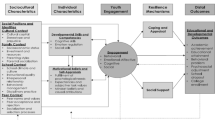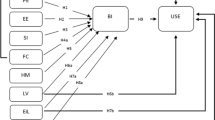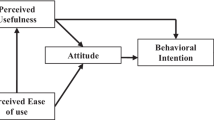Abstract
This paper presents the systematic development of a ‘Uses and Gratification Expectancy’ (UGE) conceptual framework which is able to predict students’ ‘Perceived e-Learning Experience. ’ It is argued that students’ UGE as regards e-learning resources cannot be implicitly or explicitly explored without first examining underlying communication theories and learning perspectives. As such, the theoretical framework is grounded in the confluence of theories from communication theories and learning perspectives. The integration of Expectancy-value Theory, and the Uses and Gratification Theory serves to accommodate the suggestion that elearning resources offer gratifications that are expected and valued by students. The key theoretical and practical assumptions of the UGE approach are highlighted and consistently implemented in the conceptual edifice.
Similar content being viewed by others
References
Andrews, K. (2004). National and international trends in the knowledge economy: A review of the literature.Australian flexible learning framework. Australian National Training Authority (ANTA). Retrieved December 28, 2005 from http://www. flexiblelearning.net.au/projects/resources/PDFutureA.d oc
Bandura, A. (1986).Social foundations of thought and action: A social cognitive theory. Englewood Cliffs, NJ: Prentice Hall.
Bandura, A. (1997).Self-efficacy: The exercise of control. New York: Freeman.
Beauschel, W., Gaiser, B., & Draheim, S. (2003). Communication needs of on-line students. In Anil Aggarwal (Ed.),Web-based education: Learning from experience (pp. 203–220). London: Information Science.
Brandt, R. S., & Perkins, D. N. (2000). The evolving science of learning. In Ronald S. Brant (Ed.),Education in a New Era (pp.159–183). Virginia, U.S.A: Association for supervision and Curriculum Development (ASCD).
Bryant, J. (2002). Entertainment as media effect. In J. Bryant, & D. Zillmann, (Eds.),Media Effects: Advances in Theory and Research, 525–544. Hillsdale, NJ: Lawrence Erlbaum Associates. Retrieved November 23, 2006, from http://wf2dnvr1.webfeat.org: 80/rn8nG183/url=http://site.ebrary.com/lib/mmulibrary /Doc?id=10084673&ppg=536
Chandler, D. (1994).Why do people watch television? MCS. UWA 1994. Retrieved April, 8, 2006, from http://www.aber.ac.uk/media/Documents/short/ usegrat.html
Chickering, A. W., & Gamson, Z. F. (1991).Applying the seven principles for good practice in undergraduate education (New directions for teaching and learning). San Francisco: Jossey-Bass.
Conner, M. L. (2002).A primer on educational psychology. Retrieved January 28, 2007 from http://agelesslearner. com/intros/edpsych.html
DeFleur, M. L., & Ball-Rokeach, S. (1989).Theories of mass communication. New York: Longman
Eastin, M. S., & LaRose, R. (2000). Internet self-efficacy and the psychology of the digital divide.Journal of Computer-Mediated Communication. Retrieved December 26, 2005, from http://jcmc.indiana.edu/ vol6/issue1/eastin.html
Ebersole, S. (2000). Uses and gratifications of the web among students.Mass Communications and Center for New Media, University of Southern Colorado. Retrieved January 22, 2007 from http://jcmc.indiana.edu/ vol6/issue1/ebersole.html
Eighmey, J., & McCord, L. (1998). Adding value in the information age: Uses and gratifications of sites on the world wide web.Journal of Business Research 41(3), 187–194. Retrieved November 23, 2006, from http://www.ingentaconnect.com/search/expand?pub=in fobike://els/01482963/1998/00000041/00000003/art00 061&unc=
Garrison, D. R., & Anderson, T. (2003).E-learning in the 21st century: A framework for research and practice. London: Routledgefalmer.
Golbeck, A. L. (1986).Evaluating statistical validity of research reports: a guide for managers, planners, and researchers. Retrieved December 29, 2006, from http://www.fs.fed.us/psw/publications/documents/psw_ gtr087/psw_gtr087.pdf
Hamilton, N. T. (1998). Uses and gratifications theory.For theories of persuasive communication & consumer decision making. Retrieved April 15, 2007, from http://www.ciadvertising.org/studies/student/98_fall/th eory/hamilton/leckenby/theory/thome.htm
Hase, S., & Kenyon, C. (2000).From andragogy to heutagogy. Original ultiBASE publication. RMIT University. Retrieved January 2, 2006, from http://ultibase.rmit.edu.au/Articles/dec00/hase2.htm
Hayashi, A., Chen, C., Ryan, T., & Wu, J. (2004). The role of social presence andmoderating role of computer self efficacy in predicting the continuance usage of elearning systems.Journal of Information Systems Education. West Lafayette: Summer 2004.15(2) 139 - 145. Retrieved May 23, 2007, from http://www. findarticles.com/p/articles/mi_qa4041/is_200407/ai_n9 437383
Heinich, R., Molenda, M., Russel, J. D., & Smaldino, S. E. (1996).Instructional media and technologies for learning. London: Prentice-Hall.
Hofstetter, F. T. (2001).Multimedia literacy. New York: McGraw-Hill Irwin.
Honey, P., & Mumford, A. (1986).Using your learning styles. Berkshire: Maidenhead.
Infed (2005).Howard Gardner, multiple intelligences and education. Encyclopaedia: Archives-explore. Retrieved October 22, 2005, from http://www.infed.org/ thinkers/gardner.htm
Infrastructure (2005). Infrastructure: Multimedia super corridor.Star Publications. Retrieved October 8, 2005, from http://allmalaysia.info/msiacommerce/infrastructure/ msc.asp
Jacobs, G. (2005). Hypermedia and discovery based learning: What value?Australasian Journal of Educational Technology, 21(3), 355–366. Retrieved May 23, 2007, from http://www.ascilite.org.au/ ajet/ajet21/jacobs.html
Katz, E., Blumler, J. G., & Gurevitch, M. (1974).The uses of mass communication. Beverly Hills, CA: Sage.
Khosrow-Pour, M. (2002).Web-based instructional learning. London: IRM Press
Kolb, D. A. (1984)Experiential learning, Englewood Cliffs, NJ: Prentice Hall.
Laird, D. (1985).Approaches to training and development. Reading, Massachusetts: Addison-Wesley. Retrieved on December 17, 2005 from http://www.brookes.ac.uk/ services/ocsd/2_learntch/theories.html
Levy, M. R., & Windahl, S. (1985). The concept of audience activity. In K. E. Rosengren, L. A. Wenner, & P. Palmgreen (Eds.),Media gratifications research: Current perspectives, 109–122. Beverly Hills, CA: Sage.
Littlejohn, S. W. (1996).Theories of human communication. New York: Wadsworth.
Lombard, M., & Dittonn, T. (1997). At the heart of it all: The concept of presence.Journal of Computer- Mediated Communication, 3 (2). Retrieved May 17, 2005, from http://jcmc.indiana.edu/vol3/issue2/ lombard.html#rRice92
Luo, X. (2002). Uses and gratifications theory and econsumer behaviors: A structural equation modeling study.Journal of Interactive Advertising, 2 (2). Retrieved October 12, 2006, from http://jiad.org/ vol2/ no2/luo/
Marzano, R. J. (1998).A theory-based meta-analysis of research on instruction. Aurora, CO: Mid-continent Research for Education and Learning.
McQuail, D. (2000).Mass communication theory. Thousand Oaks, London: Sage Publications.
Munro, R. A., & Rice-Munro, E. J. (2004). Learning styles, teaching approaches, and technology.The Journal for Quality and Participation, 27(1), 26–33. Cincinnati: Spring. Retrieved October 14, 2005, from http:// proquest.umi.com/pqdweb?did=628727781&sid=1&F mt=3&clientId=24792&RQT=309&VName=PQD
Pajares, F. (2002).Overview of social cognitive theory and of self-efficacy. Retrieved November 23, 2006, from http://www.des.emory.edu/mfp/eff.html Palaigeorgiou, G. E., Siozos, P. D., Konstantakis, N. I., &
Tsoukalas, I. A. (2005). A computer attitude scale for computer science freshmen and its educational implications.Journal of Computer Assisted Learning, 21(5), 330–342. Retrieved January 28, 2006, from http://www.blackwell-synergy.com/doi/full/10.1111/ j.1365-2729.2005.00137.x#h22
Palmgreen, P., & Rayburn, J. D. (1985). An expectancyvalue approach to media gratifications. In K. E. Rosengren, P. Palmgreen, & L. A. Wenner (Eds.),Media Gratification Research: Current Perspectives, 61–72. Beverly Hills, CA: Sage.
Palmgreen, P., Wenner, L., & Rosengren, K. (1985). Uses and gratifications research: The past ten years. In K. Rosengren, L.Wenner, & P. Palmgreen (Eds.),Media gratifications research, 11–37. Beverly Hills, CA: Sage.
Papacharissi, Z., & Rubin, A. M. (2000). Predictors of internet use.Journal of Broadcasting and Electronic Media.44 (2), 175–196. Retrieved November 23, 2006, from http://www.questia.com/PM.qst?a=o&d=500175 440&er=deny
Papert, S. (1993).Mindstorms: Children, computers, and powerful ideas. New York: Basic Books, A member of The Perseus Books Group. Retrieved January 3, 2006, from http://www.amazon.com/gp/reader/0465046746/ ref=sib_rdr_zmout/104-1437820-3493568?%5Fencoding=UTF8&p=S001#reader-page
Peckham, K. (2005).Instructional design methodologies for synthetic environments. Retrieved November 17, 2006, from www.siaa.asn.au/get/2411856094.pdf -
Piaget, J. (1969).The mechanisms of perception. New York: Basic Books
Rubin, A. M. (2002). Media uses and effects: A uses and gratifications perspective. In J. Bryant and D. Zillmann, (Eds.),Media effects: advances in theory and research, 525–544. Hillsdale, NJ: Lawrence Erlbaum Associates. Retrieved November 23, 2006, from http:// wf2dnvr1.webfeat.org:80/rn8nG183/url= http://site.ebrary. com/lib/mmulibrary/Doc?id=10084673&ppg=536
Ruggiero, T. E. (2000). Uses and gratifications theory in the 21st century.Mass Communication and Society, 3 (1), 3–37. Retrieved October 14, 2006, from http://www. leaonline.com/doi/abs/10.1207/S15327825MCS0301_0 2?journalCode=mcs
Schlöglmann, W. (2001).Affect and cognition - Two poles of a learning process. Wolfgang Universität Linz. A - 4040 Linz, Austria. Retrieved November 23, 2006, from http://www.education.monash.edu.au/centres/ sciencemte/docs/vamp/schloglmann2001.pdf
Schunk, D. H. (1991).Learning theories: An educational perspective. New York: Macmillan.
Schwartz, D. (1999).Ghost in the machine: Seymour Papert on how computers fundamentally change the way kids learn. Retrieved May 29, 2007, from http://www.papert.org/articles/GhostInTheMachine.html
Severin W. J., & Tankard, J. W. (1997). Uses of mass media. In W. J. Severin, & J. W. Tankard (Eds.),Communication theories: Origins, methods, and uses in the mass media (4th ed.). New York: Longman.
Shedroff, N. (2001).Experience design. Indiana: New Riders.
Sherry, A. C. (1998). Evaluation of multimedia authoring instruction based in a behaviorist-cognitiveconstructivist continuum.International Journal of Instructional Media, 25(2), 201–217. New York: 1998. Retrieved January 28, 2007 from http://proquest.umi. com/pqdlink?did=30132403&sid=2&Fmt=4&clientId= 24792&RQT=309&VName=PQD
Stafford, T. F., Stafford, M.R., & Schkade, L.L. (2004). Determining uses and gratifications for the internet.Decision Sciences. 35(2), 259. Retrieved October 17, 2006, from http://www.blackwell-synergy.com/ links/doi/10.1111/j.00117315.2004.02524.x/full/
Vroom, V. (1995).Work and motivation. San Francisco: Jossey-Bass Publishers
Windham, C. (2005). Father goggle mother & IM: Confessions of a net gen learner.Educause. Retrieved October 6, 2005, from http://www.educause.edu/ir/ library/pdf/ERM0552.pdf
Zemsky, R., & Massy, W. F. (2004). Thwarted innovation: What happened to e-learning and why: A learning alliance report.The Weatherstation Project of The Learning Alliance at the University of Pennsylvania in cooperation with the Thomson Corporation. Retrieved on April 10, 2007, from http://www.irhe.upenn.edu/ Docs/Jun2004/ThwartedInnovation.pdf
Author information
Authors and Affiliations
Corresponding author
Rights and permissions
About this article
Cite this article
Mondi, M., Woods, P. & Rafi, A. Students’ ‘uses and gratification expectancy’ conceptual framework in relation to E-learning resources. Asia Pacific Educ. Rev. 8, 435–449 (2007). https://doi.org/10.1007/BF03026472
Received:
Revised:
Accepted:
Issue Date:
DOI: https://doi.org/10.1007/BF03026472




